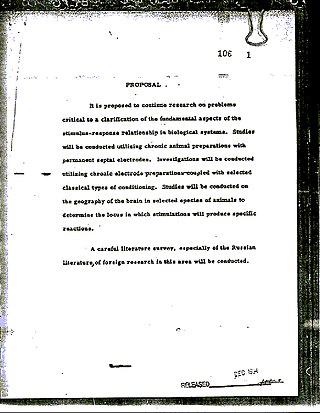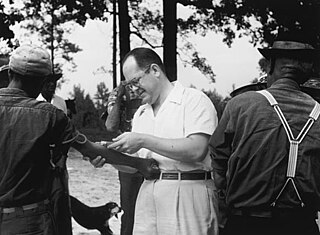Related Research Articles

"Truth serum" is a colloquial name for any of a range of psychoactive drugs used in an effort to obtain information from subjects who are unable or unwilling to provide it otherwise. These include ethanol, scopolamine, 3-quinuclidinyl benzilate, midazolam, flunitrazepam, sodium thiopental, and amobarbital, among others.

Project MKUltra was an illegal human experimentation program designed and undertaken by the U.S. Central Intelligence Agency (CIA) and intended to develop procedures and identify drugs that could be used during interrogations to weaken people and force confessions through brainwashing and psychological torture. It began in 1953 and was halted in 1973. MKUltra used numerous methods to manipulate its subjects' mental states and brain functions, such as the covert administration of high doses of psychoactive drugs and other chemicals without the subjects' consent, electroshocks, hypnosis, sensory deprivation, isolation, verbal and sexual abuse, and other forms of torture.
Incapacitating agent is a chemical or biological agent which renders a person unable to harm themselves or others, regardless of consciousness.

Frank Rudolph Emmanuel Olson was an American bacteriologist, biological warfare scientist, and an employee of the United States Army Biological Warfare Laboratories (USBWL) who worked at Camp Detrick in Maryland. At a meeting in rural Maryland, he was covertly dosed with LSD by his colleague Sidney Gottlieb and, nine days later, plunged to his death from the window of the Hotel Statler in New York. The U.S. government first described his death as a suicide, and then as misadventure, while others allege murder. The Rockefeller Commission report on the CIA in 1975 acknowledged their having conducted covert drug studies on fellow agents. Olson's death is one of the most mysterious outcomes of the CIA mind control project MKUltra.
Sidney Gottlieb was an American chemist and spymaster who headed the Central Intelligence Agency's 1950s and 1960s assassination attempts and mind-control program, known as Project MKUltra.

MKNAOMI is the code name for a joint Department of Defense/CIA research program from the 1950s through to the 1970s. Unclassified information about the MKNAOMI program and the related Special Operations Division is scarce. It is generally reported to be a successor to the MKULTRA project focusing on biological projects including biological warfare agents—specifically, to store materials that could either incapacitate or kill a test subject and to develop devices for the diffusion of such materials.
Project Chatter was a United States Navy program beginning in the fall of 1947 focusing on the identification and testing of drugs in interrogations and the recruitment of agents. Their search included laboratory experiments on both animal and human subjects. The program operated under the direction of Charles Savage of the Naval Medical Research Institute, Bethesda, Maryland, from 1947 to 1953. The project was geared to identifying agents both synthetic and natural that were effective during interrogation, as well as testing possible treatments for depression. The project was centered on, but not restricted to, the use of anabasine, scopolamine and mescaline. It was the first U.S. government project in which lysergic acid diethylamide (LSD-25) was used on human subjects. The Navy ended the project in 1953 when its experiments were merged into Project MKULTRA.
The Office of Technical Service is a component of the U.S. Central Intelligence Agency, responsible for supporting CIA's clandestine operations with gadgets, disguises, forgeries, secret writings, and weapons. The OTS traces its history to October 1942, when OSS director William J. Donovan created the OSS Research and Development Branch, a technical group tasked with creating "dirty tricks and deadly weapons" to combat the US's World War II enemies. Donovan named Cornell University-trained chemist and executive Stanley Platt Lovell as the branch's first head, a man whom the CIA remembers as the "founding father" of the OTS. In the 1950s and early 1960s it also researched, investigated, and experimented with the use of drugs, chemicals, hypnosis, and isolation to extract information during interrogation, as well as to make it easier for American captives to resist interrogation. OTS is part of CIA's Directorate of Science and Technology.

The United States President's Commission on CIA Activities within the United States was ordained by President Gerald Ford in 1975 to investigate the activities of the Central Intelligence Agency and other intelligence agencies within the United States. The Presidential Commission was led by Vice President Nelson Rockefeller, from whom it gained the nickname the Rockefeller Commission.

Project FUBELT is the codename for the secret Central Intelligence Agency operations that were to prevent Salvador Allende's rise to power before his confirmation and to promote a military coup in Chile. This project came after the circumstantial failure of Track I, which involved making president Eduardo Frei Montalva interfere with the 1970 national election in opposition to Allende.
Cathy O'Brien is an American conspiracy theorist and author who claims to have been a victim of a government mind control program called "Project Monarch", which she alleges was part of the CIA's Project MKUltra. O'Brien made these assertions in Trance Formation of America (1995) and Access Denied: For Reasons of National Security (2004), both of which she co-authored and self-published with her husband, Mark Phillips. According to scholars, there is no credible evidence for O'Brien's claims and there are numerous inconsistencies with her story.
Pharmacological torture is the use of psychotropic or other drugs to punish or extract information from a person. The aim is to force compliance by causing distress, which could be in the form of pain, anxiety, psychological disturbance, immobilization, or disorientation.
Operation Midnight Climax was an operation carried out by the CIA as a sub-project of Project MKUltra, the mind-control research program that began in the 1950s. It was initially established in 1954 by Sidney Gottlieb and placed under the direction of the Federal Bureau of Narcotics in Boston, Massachusetts with the "Federal Narcotics Agent and CIA consultant" George Hunter White under the pseudonym of Morgan Hall. Dr. Sidney Gottlieb was a chemist who was chief of the Chemical Division of the Office of Technical Service of the CIA. Gottlieb based his plan for Project MKUltra and Operation Midnight Climax off of interrogation method research under Project Artichoke. Unlike Project Artichoke, Operation Midnight Climax gave Gottlieb permission to test drugs on unknowing citizens, which made way for the legacy of this operation. Hundreds of federal agents, field operatives, and scientists worked on these programs before they were shut down in the 1960s.
Operation WASHTUB was a covert operation organized by the United States Central Intelligence Agency to plant a phony Soviet arms cache in Nicaragua. It was a part of the CIA's effort to portray the administration of Guatemalan President Jacobo Árbenz as having ties to the Soviet Union, prior to the CIA sponsored 1954 Guatemalan coup d'état which overthrew Árbenz later the same year. On 19 February 1954, the CIA, working through the Guardia Nacional de Nicaragua, planted a cache of Soviet-made arms on the Nicaraguan coast near the fishing village of Masachapa to be "discovered" weeks later by Rafael Lola, a lieutenant in the Nicaraguan army, and fishermen in the pay of Nicaraguan president Anastasio Somoza García. The CIA also wished to dispose of the weapons, which were to have been used by Carlos Castillo Armas, and were therefore incriminating to the CIA. On May 7, 1954, President Somoza told reporters at a press conference that a Soviet submarine had been photographed, but that no prints or negatives were available. The story presented to the press was embroidered with the involvement of Guatemalan assassination squads. Somoza was supposed to convince the public that the arms had been intended for Guatemala. The press and the public were skeptical and the story did not get much press. However, the story became part of the Nicaragua local legends until the 1979 revolution.
William Joseph Bryan, Jr. (1926–1977) was an American physician and a pioneering hypnotist. He was one of the founders of modern hypnotherapy and his work notably found use in psychological warfare during the Cold War. He was a great-grandson of United States Secretary of State William Jennings Bryan.
Psychochemical warfare — or "drug weapons" — involves the use of psychopharmacological agents with the intention of incapacitating an adversary through the temporary induction of hallucinations or delirium. These agents have generally been considered chemical weapons and, more narrowly, constitute a specific type of incapacitating agent. Although never developed into an effective weapons system, psychochemical warfare theory and research—along with overlapping mind control drug research—was secretly pursued in the mid-20th century by the US military and Central Intelligence Agency (CIA) in the context of the Cold War. These research programs were ended when they came to light and generated controversy in the 1970s. The degree to which the Soviet Union developed or deployed similar agents during the same period remains largely unknown.

Numerous experiments which are performed on human test subjects in the United States are considered unethical, because they are performed without the knowledge or informed consent of the test subjects. Such tests have been performed throughout American history, but some of them are ongoing. The experiments include the exposure of humans to many chemical and biological weapons, human radiation experiments, injections of toxic and radioactive chemicals, surgical experiments, interrogation and torture experiments, tests which involve mind-altering substances, and a wide variety of other experiments. Many of these tests are performed on children, the sick, and mentally disabled individuals, often under the guise of "medical treatment". In many of the studies, a large portion of the subjects were poor, racial minorities, or prisoners.

Acid Dreams: The Complete Social History of LSD: the CIA, the Sixties, and Beyond, originally released as Acid Dreams: The CIA, LSD, and the Sixties Rebellion, is a 1985 book by Martin A. Lee and Bruce Shlain, in which the authors document the 40-year social history of lysergic acid diethylamide (LSD), beginning with its synthesis by Albert Hofmann of Sandoz Pharmaceuticals in 1938. During the Cold War period of the early 1950s, LSD was tested as an experimental truth drug for interrogation by the United States intelligence and military community. Psychiatrists also used it to treat depression and schizophrenia. Under the direction of Sidney Gottlieb, the drug was used by the Central Intelligence Agency (CIA) in cooperation with participating "colleges, universities, research foundations, hospitals, clinics, and penal institutions". LSD was tested on "prisoners, mental patients, volunteers, and unsuspecting human subjects".

Poisoner in Chief: Sidney Gottlieb and the CIA Search for Mind Control is a 2019 book by The New York Times journalist and historian Stephen Kinzer. The book contains untold stories of a Central Intelligence Agency (CIA) chemist called Sidney Gottlieb, who tried to "find a way to control the human brain". In 1953, CIA director Allen Dulles appointed Gottlieb to "run the covert program".

Paul Francis Gaynor was an American military officer and Central Intelligence Agency operative. He is best known for his involvement in Project MK Ultra, having overseen and directed its predecessor, Project ARTICHOKE. He is a recipient of the Distinguished Service Cross.
References
- Maret, Susan (2018-02-16). "Murky Projects and Uneven Information Policies: A Case Study of the Psychological Strategy Board and CIA". Secrecy and Society. 1 (2). doi: 10.31979/2377-6188.2018.010206 . ISSN 2377-6188.
- Ronson, Jon (2004). The Men Who Stare at Goats . London: Picador. ISBN 0-330-37547-4. OCLC 56653467.